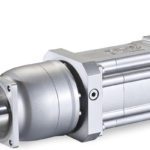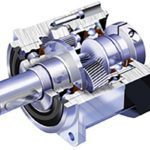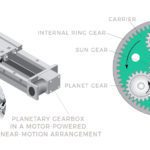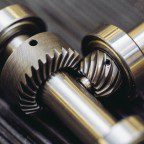
Selecting a gearbox goes beyond just determining the required speed and torque output. Duty cycle, radial and axial loads, inertia, and environment all play a factor. Not to mention the gearbox type (inline, right angle), precision level, and service factor. Properly sizing and selecting a gearbox requires consideration of all these criteria, but with numerous manufacturers and thousands of gearbox types and sizes available, it can be difficult to determine just where to start.
This is where manufacturers’ online sizing and selection tools come in. As shown in the examples below, these tools can provide significant time savings for designers and engineers by narrowing the field of choices to those that meet the most critical application criteria.
Gam’s online sizing tool is user-friendly, with a drop-down menu of pre-programmed motor manufacturers and models. Once a motor and model are selected, the rated speed, peak speed, inertia, and motor dimensions are pre-filled. The user manually enters the application’s continuous torque and peak torque values.

Based on this data, a list of suitable gearboxes is provided, and the results can be narrowed further based on criteria such as gearbox type (inline or right angle), output type, maximum backlash, allowable radial load, and allowable axial load.
After the gearbox selection is made, the full model and description are presented, along with download options for CAD files and 3D models, a request for quote option, and a list of related products such as couplings and similar gearboxes.
Gam also provides a tutorial on how to use the sizing tool.
Wittenstein (alpha) Sizing Assistant
The first step in using Wittenstein’s Sizing Assistant is to decide whether you want to perform the gearbox selection based on the application data or on the motor being used. When “application data” is selected as the input criteria, the user enters the application’s maximum torque and chooses from pre-defined motion cycles (profiles) and operating time. The gear ratio is also entered manually, and the program provides a graphical list of gearbox that meet these criteria.
Filters such as output type, gearbox type, maximum backlash, and radial and axial loads help to narrow the possible options. A nice feature of the options list is that each gearbox also shows a “utilization” percentage, which essentially indicates how much of the torque capability is required by the application (considering the service factor).

Using “motor” as the input criteria only requires selecting the motor manufacturer and model from drop-down lists and manually entering the desired gear ratio. Again, a list of suitable gearboxes is shown graphically, and filters can be used to narrow the choices. Wittenstein’s software also lets the user compare gearboxes in a side-by-side list.
Once a gearbox is selected, the software provides download options for CAD files and data sheets, as well as the option to request a quote.
Micron’s gearbox selection tool gives three options for finding the right gear reducer: by application data, by Micron model number, or by competitor’s model number.
For searching by application requirements, the user chooses the gearbox type (in-line or right angle), operation (continuous duty or cyclical), maximum backlash, and gear ratio.

Then the number of cycles per hour, torque, and speed can either be entered manually, or they can be calculated by the software based on a user-defined motion profile. After the move profile is defined, radial and axial loads can be entered (if applicable), and the motor manufacturer and model are selected via drop-down menus.
The software provides a list of gearboxes that meet the application requirements, along with list price and lead time. The user can then choose a gearbox and download a CAD model or request a quotation.
Selecting by Micron part number is extremely straightforward, requiring the user to choose the Micron model, gearbox type, frame size, and ratio. Then the user either specifies the motor information by either choosing from a list of Micron motor mount kits, choosing the motor manufacturer and model from a dropdown list, or entering the motor dimensions manually. The gearbox information is presented in the same format as above.
The competitor replacement functionality is useful for interchanging a competitor’s gearbox with the most similar Micron version, although it requires sufficient knowledge of the competitor’s part number in order to provide a cross-reference.







Leave a Reply
You must be logged in to post a comment.